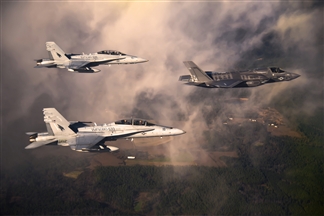
Milestone Achievement for the F-35
 The F-35 Lightening II resumed operational flights last week. This is a big achievement for the Joint Strike Fighter program, and particularly for the Marines, whose version of the JSF, the F35B, returned after a temporary grounding late last month.
The F-35 Lightening II resumed operational flights last week. This is a big achievement for the Joint Strike Fighter program, and particularly for the Marines, whose version of the JSF, the F35B, returned after a temporary grounding late last month.
Wading through the acquisition process for any aircraft is exceedingly difficult, but if anyone can make it work, it’s the Marines. Take the V-22 for example. The complexities of this multi-purpose aircraft, the first of its kind, lead to schedule delays and cost overruns early in development. However, the Marine Corps remained committed to the program, since V-22 promised to significantly enhance our air power capabilities.
Today, it’s clear that the V-22 was a smart investment. Despite adversity early on, the V-22 is now proving to be one of the safest and most effective aircraft the Marines have ever possessed.
The F-35B has a similar story. Two years ago the Marine variant was placed on probation after encountering problems in the propulsion and lift systems. Rather than cancelling the program, Pentagon planners gave the plane’s developers two years to fix the problems.
It only took one year. By January 2012, probation was lifted and the F-35B returned to full status production. Now, one year later, the F-35B encountered another technical difficulty, corrected it, and returned to operational flights within one month.
The F-35’s success despite setbacks is a lesson in long-term thinking about defense acquisitions. Programs that take years to develop are bound to encounter obstacles. If we cut every program when a technical difficulty cropped up, we wouldn’t have much of a military force.
As Former Secretary of Defense Leon Panetta once said, “We need to make sure we are on the cutting edge.” That means investing in programs like the F-35 that Pentagon officials deem “absolutely vital to maintaining our air superiority.”
Rather than rushing to cut the F-35 over technical hiccups, we should be asking strategic questions about the program and our broader acquisitions plan: Do we need this capability? How many and when? How do we make sure the program is well-managed and cost-effective?
Cutting back may save a little in the short-term, but it will certainly hurt our long-term defense capabilities. Like the V-22, the F-35 can be a great platform, if we manage it well and invest the resources necessary for success.






[…] Milestone Achievement for the F-35 […]